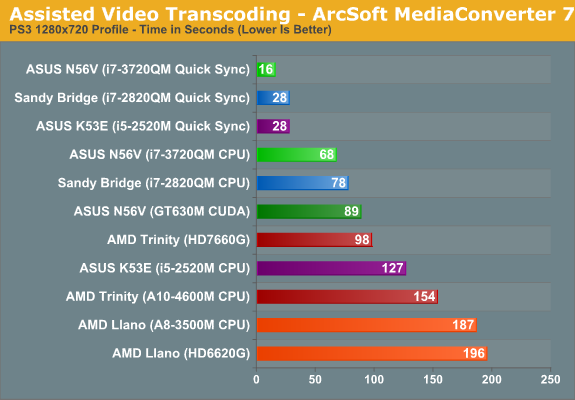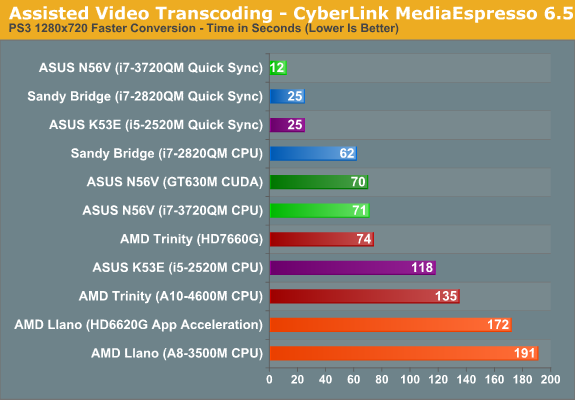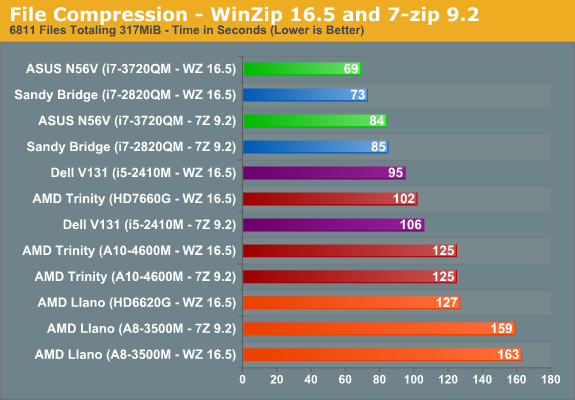The AMD Trinity Review (A10-4600M): A New Hope
by Jarred Walton on May 15, 2012 12:00 AM ESTAMD’s Heterogeneous Computing with Trinity
It’s not all about just CPU or GPU performance, though—or at least that’s what we’ve been hearing from various parties for a while now. The real question is how a platform performs as a whole. There are some tasks where pure CPU performance is what really matters, and there are other tasks where the parallel nature of GPUs pays serious dividends. AMD (and NVIDIA) has been pushing for more applications to make use of the GPU for tasks where it can provide a lot of number crunching prowess.
With Trinity, AMD provided us with a selection of applications that now leverage—to varying degrees—AMD’s App Acceleration, OpenCL, OpenGL, or other tools. For some of these applications, we don’t have any good way of measuring performance across a wide selection of hardware, and for some of those where benchmarks are possible I’ve run out of time to try to put anything concrete together. I don’t want to skip this section entirely, so what follows is a list of the applications, how they benefit from heterogeneous compute, and some general impressions of the application. We also have graphs for a few of the applications where performance seemed to matter the most.
Adobe Flash 11.2—The latest version of Flash continues to add GPU acceleration features, and now there are 3D hooks in addition to the video offload acceleration we first saw with Flash 10.x. There’s not too much of note here, as NVIDIA and Intel also support the latest features of Flash 11.2. Flash works fine on Trinity, but the same goes for Ivy Bridge and various NVIDIA GPUs. If you never saw the Epic Citadel demo for iOS or Android, there’s now a Flash-based version of the same demo that will run in your browser. (Warning: that link can take 10-15 minutes on a decent connection to download all the textures and other data!) Epic Citadel looks just as nice as it did on iOS, but now we need some actual games to take advantage of the tools. Then perhaps we can start looking into benchmarks of browser games or something….
Adobe Photoshop CS6—Photoshop started to take advantage of GPU acceleration back with the CS4 release, using OpenGL to improve performance on certain filters and features. With CS6, Adobe has begun using OpenCL. Fundamentally, I’m not sure how big of a change this represents, but there are quite a few functions in Photoshop that are now supposed to be faster/better with an OpenCL compatible graphics card. There are also two new features that leverage OpenCL; one is Iris Blur, which allows you to mimic depth of field using Photoshop instead of your camera, and the other is Liquify. Unfortunately, I’m by no means a Photoshop expert, so I’m not sure how much the features really help “power users”. I did try doing a benchmark of general Photoshop CS6 performance using the Photoshop Retouch benchmark with and without GPU acceleration enabled; unfortunately, it looks like most of the filters in that action script don’t benefit from the GPU acceleration, as the scores I got were essentially unchanged with or without GPU/OpenCL enabled. Overall, I’ll take the GPU acceleration, but for most of what I do in Photoshop it doesn’t appear to benefit; if you’re interested, you can read more about AMD’s work with Adobe.
GNU Image Manipulation Program (GIMP)—Going along with Photoshop CS6, AMD provided a special preview build of GIMP 2.8. GIMP is sort of the poor man’s Photoshop, as it’s completely free. At present, there are 19 filters that utilize OpenCL to speed of processing, and over the coming months as the release version of GIMP looks to take their new engine live there will undoubtedly be more additions. For now, probably only five of the filters are things I would use (e.g. noise reduction, maybe a light blur). I tested several of these, and there is sometimes an order of magnitude speedup vs. doing the work on just the CPU. The problem is that it also looks like GIMP isn't incredibly well threaded in many of these tasks, putting multicore CPUs at a disadvantage. My biggest complaint isn’t even about performance, though; sadly, I just find the GIMP UI and general performance to be really bad compared to Photoshop. I've tried several times over the years to use GIMP instead of Photoshop, but I’ve never felt comfortable with the tool. If on the other hand you prefer GIMP, hopefully when the current GEGL menu gets integrated into the main program you’ll realize a healthy performance boost.

ArcSoft MediaConverter 7.5—MediaConverter should be a familiar name by now if you’ve been following our reviews, as it’s one of the showcase titles for Intel’s Quick Sync transcoding. When we reviewed Ivy Bridge last month, we found that on Llano at least the version of MediaConverter we had ran slower on the GPU than on the CPU; with Trinity on the other hand, enabling GPU acceleration results in times that are about 60% faster than the CPU alone. That’s a good performance increase, but we’re looking at 154 seconds on the CPU compared to 98 seconds using the GPU. In contrast, dual-core Sandy Bridge on CPU transcoding took 127 seconds and with Quick Sync it only took 28 seconds—a 5X improvement. Quad-core Ivy Bridge was just as impressive, going from 68 seconds on the CPU down to 16 seconds with Quick Sync (4.25X). We’ve been hoping to see something more from AMD’s new Video Codec Engine (VCE), first announced over six months ago with HD 7970, but unless there’s substantial room for improvement it looks like Intel’s Quick Sync will continue to be the fastest transcoding tool for now.

CyberLink MediaEspresso 6.5—This tool is very similar to MediaConverter, and the results are also better this time around. We measured the assisted encode time at 74 seconds compared to 135 seconds on the CPU alone. The 74 second transcode time actually makes Trinity potentially faster than CPU-based transcoding on dual-core Sandy Bridge, but again Quick Sync (25 seconds on SNB, 12 seconds on IVB) remains the fastest way to transcode. Considering both of these tools are apparently using VCE, I have to state that I’m disappointed; with VCE I was expecting performance similar to what Intel is getting with Quick Sync—four or five times faster than CPU-based encoding for the same APU. That Trinity isn't quite twice as fast with VCE is unfortunate; even though there's a decent improvement, Intel is in a completely different category of performance. We’ll have to wait and see if anything more develops with VCE.

Handbrake— Yep, this popular open source video transcoding app is getting an OpenCL facelift. Check out our separate post on it here.
WinZip 16.5—This final application is one that I can see being very useful, assuming we see similar advancements in other compression utilities. WinZip 16.5 now supports OpenCL to improve compression times. We tested by compressing the entire Cinebench 11.5 directory with and without OpenCL enabled, and we also compared the results with 7-Zip. On Trinity, performance improved by about 20%, which is decent; Llano sees an even larger 28% improvement. Meanwhile, Sandy Bridge using CPU-based compression is about as fast as Trinity with OpenCL, and Ivy Bridge is still faster, but the 20% increase for “free” is nothing to scoff at. Unfortunately for WinZip, 7-Zip compressed the same directory to 95MB vs. 108MB in roughly the same time as the non-OpenCL WinZip, and 7-Zip is completely free and doesn't nag you and tell you to buy it. Where WinZip 16.5 is a good proof of concept, what will really help AMD is if all the other compression utilities (7-Zip, WinRAR, etc.) all start using OpenCL or other tools to improve performance.
The majority of the applications continue to focus on video and image manipulation, likely because those are areas where the parallel nature of GPUs can be readily utilized. WinZip on the other hand is an application showing other potential uses for GPGPU and heterogeneous compute. We’d love to see even more adoption of OpenCL and similar tools, but the stark reality is that coming up with new and useful ways of doing this is difficult—if it were easy, everyone would do it! The good news is that giving the creative people of the world more tools with which to work can only help, and we’ll just have to wait and see what else comes out.
There’s another interesting sidebar worth mentioning here. OpenCL is an open standard, and the latest Intel drivers actually install an OpenCL driver on Ivy Bridge and Sandy Bridge. Not surprisingly, not all implementations are created equal, so even with Intel’s drivers we couldn’t enable OpenCL in Photoshop or WinZip; GIMP on the other hand apparently worked okay with OpenCL on Intel—we measured a 5X performance improvement of the Noise Reduction filter with Ivy Bridge. Trinity also came in slightly faster with both leveraging OpenCL, while Intel was nearly twice as fast without.










271 Comments
View All Comments
AlB80 - Tuesday, May 15, 2012 - link
No.It's official information.
JarredWalton - Tuesday, May 15, 2012 - link
Except according to CLInfo, it does. Nice try?AlB80 - Tuesday, May 15, 2012 - link
Oops. It was.Now it has fp64 = 1/16 fp32.
princehamlet - Tuesday, May 15, 2012 - link
I was constantly refreshing the page at 12 AM! Couldn't wait for the reviews to be posted after the embargo was lifted :D.BSMonitor - Tuesday, May 15, 2012 - link
Why? Nothing earthshattering here. AMD is scalping resources from the CPU to add TDP room and die space for more of it's bulky Radeon shaders.It's like buying a laptop from 2004, with a DX11 upgrade.
AMD has the "good enough" part backwards. People want their laptop to be responsive when doing work, watching movies and browsing, etc. CPU intensive tasks. The good enough part, in regards to laptops would be the gaming. No one expects 60fps at 1080 out of laptop sitting on a plane flying somewhere.
Way to capture the hearts of the 1% of the 1% of people looking for great gaming from their $500 laptop.
Articuno - Tuesday, May 15, 2012 - link
Considering the CPU part is better than mobile Core 2 Duo parts (and thousands upon thousands of people are still using laptops with C2Ds) and the GPU part is several orders of magnitude better than Intel's best, I'd say buying an Intel laptop is like buying a laptop from 2004: expensive and extremely low price/performance for what you get.JarredWalton - Tuesday, May 15, 2012 - link
Whoa... several orders of magnitude? So, like, 1000X better? Because if anyone can offer up a GPU that's 1000 times faster than even GMA 4500, I'd take it! Turning down the hyperbole dial: AMD still has better drivers than Intel, but it's more like 20% better (just to grab a nice number out of thin air). Trinity's GPU is about 20% faster than HD 4000 as well, so that makes Trinity's GPU a whopping 44% better than "Intel's best".Now if you want to talk about the best Core 2 era IGP, then we'd be looking at more like an order of magnitude improvement. GMA 4500MHD scores around 1000 in 3DMark06, in case you were wondering (http://www.anandtech.com/show/2818/6). I know, it's only 3DMark -- still, call it 500 as a penalty for lousy drivers and HD 7660G is still "only" about 20X better.
/meaningless debate
Articuno - Tuesday, May 15, 2012 - link
Fair enough, kind of a knee-jerk reaction out of me there. Though I'm guessing the APU will be cheaper than the i7s it's going up against even without a discrete card added on top of them, so it's got very nice price/performance potential.jensend - Tuesday, May 15, 2012 - link
Yes, his "orders of magnitude" was hyperbole- but Intel's benchmark scores esp 3dmark really haven't reflected how awful their GPUs have been. The performance difference in real games was usually much bigger than that in synthetic benchmarks. You already mentioned driver issues. Even if you could get halfway decent performance out of some games, image quality was often a huge problem. If AMD or nV had offered that crappy of image quality they would have been totally excoriated in the press for cheating in order to inflate benchmarks; people didn't do that to Intel- probably because it would have felt like beating a handicapped child.But Sandy had some real improvements and then Ivy Bridge really turned things around for Intel. Beyond the performance improvements, after years of making excuses for their AF and saying that AA was unnecessary, they finally stopped making excuses and fixed them. Trinity is faster, but anybody who says that Ivy Bridge's graphics don't offer Trinity's any competition is badly mistaken.
Spunjji - Tuesday, May 15, 2012 - link
Indeed - I was honestly pleasantly surprised to see HD4000 sitting so high in the charts. Finally I won't need to start warning people against Intel notebooks!...except for the small problem of HD2500. Still, improvement is improvement.